Dolphin/File Management/de: Difference between revisions
No edit summary |
(Updating to match new version of source page) |
||
| Line 42: | Line 42: | ||
'''Einen neuen Ordner erstellen''': Sie können einen neuen Ordner im aktuellen Verzeichnis mittels <menuchoice>Kontextmenü (Rechtsklick) → Neu → Ordner</menuchoice> oder der Taste <keycap>F10</keycap> erstellen. | '''Einen neuen Ordner erstellen''': Sie können einen neuen Ordner im aktuellen Verzeichnis mittels <menuchoice>Kontextmenü (Rechtsklick) → Neu → Ordner</menuchoice> oder der Taste <keycap>F10</keycap> erstellen. | ||
<span class="mw-translate-fuzzy"> | |||
''Registerkarten'': '''Dolphin''' unterstützt Registerkarten-Browsen. Eine neue Registerkarte kann über <menuchoice>Datei → Neue Registerkarte</menuchoice> mit der Tastenkombination <keycap>Strg + T</keycap> oder wenn Sie mit der mittlere Maustaste auf ein Ordnersymbol oder Navigationsknöpfe klicken, geöffnet werden. | ''Registerkarten'': '''Dolphin''' unterstützt Registerkarten-Browsen. Eine neue Registerkarte kann über <menuchoice>Datei → Neue Registerkarte</menuchoice> mit der Tastenkombination <keycap>Strg + T</keycap> oder wenn Sie mit der mittlere Maustaste auf ein Ordnersymbol oder Navigationsknöpfe klicken, geöffnet werden. | ||
</span> | |||
{{Note|Starting from KDE 4.7, Dolphin's menu bar is hidden, but easy to reach and restore. If you prefer menu bar to be present, you can enable it by selecting <menuchoice> Control -> Show Menubar</menuchoice> or pressing <keycap>Ctrl + M</keycap>.}} | |||
'''Dolphin''' öffnet standardmäßig, wenn Sie auf irgendeinen Ordner klicken. Das Programm kann auch vom [[Special:myLanguage/Plasma/Kickoff|Kickoff Menü]] gestartet werden. | '''Dolphin''' öffnet standardmäßig, wenn Sie auf irgendeinen Ordner klicken. Das Programm kann auch vom [[Special:myLanguage/Plasma/Kickoff|Kickoff Menü]] gestartet werden. | ||
<span class="mw-translate-fuzzy"> | |||
== Adressleiste == | == Adressleiste == | ||
</span> | |||
<span class="mw-translate-fuzzy"> | |||
'''Dolohin''' beinhaltet ein neues Konzept, mit dem die Adressleiste schneller und präziser verwendet werden kann: die „Brotkrumen“-Adressleiste. Anstatt den kompletten Pfad darzustellen, werden nur die einzelnen Navigationspunkte, beginnend von einem Ihrer Orte, als Knopf dargestellt. Durch Klicken einer dieser Knöpfe gelangen Sie direkt zu besagtem Ordner. Auf diese Art können Sie einen übergeordneten Ordner von einem Unterordner aus rasch erreichen. | '''Dolohin''' beinhaltet ein neues Konzept, mit dem die Adressleiste schneller und präziser verwendet werden kann: die „Brotkrumen“-Adressleiste. Anstatt den kompletten Pfad darzustellen, werden nur die einzelnen Navigationspunkte, beginnend von einem Ihrer Orte, als Knopf dargestellt. Durch Klicken einer dieser Knöpfe gelangen Sie direkt zu besagtem Ordner. Auf diese Art können Sie einen übergeordneten Ordner von einem Unterordner aus rasch erreichen. | ||
</span> | |||
Zwischen den Knöpfen, die die Ordner widerspiegeln, befinden sich kleine Pfeile, die ebenfalls Knöpfe sind. Durch Klicken auf einen dieser Pfeile können Sie die Unterordner des jeweiligen Ordners sehen und somit schnell zu ihnen navigieren. | Zwischen den Knöpfen, die die Ordner widerspiegeln, befinden sich kleine Pfeile, die ebenfalls Knöpfe sind. Durch Klicken auf einen dieser Pfeile können Sie die Unterordner des jeweiligen Ordners sehen und somit schnell zu ihnen navigieren. | ||
| Line 56: | Line 64: | ||
<span class="mw-translate-fuzzy"> | |||
Es gibt ebenfalls eine klassische Adressleiste, die den kompletten Pfad anzeigt. Um dieser Ansicht zu verwenden, können Sie <menuchoice>Ansicht → Adressleiste → Vollständigen Pfad anzeigen</menuchoice> wählen oder die Tastenkombination <keycap>Strg + L</keycap> verwenden. Durch Klicken auf den freien Bereich neben der Adressleiste können Sie ebenfalls zur klassischen Ansicht wechseln. In der klassischen Ansicht ist ein Häkchen am Ende der Adressleiste sichtbar, welches wieder zur Brotkrumen-Ansicht wechselt. Natürlich können die zuvor genannten Methoden auch wieder verwendet werden, um zur vorigen Ansicht zurückzukehren. | Es gibt ebenfalls eine klassische Adressleiste, die den kompletten Pfad anzeigt. Um dieser Ansicht zu verwenden, können Sie <menuchoice>Ansicht → Adressleiste → Vollständigen Pfad anzeigen</menuchoice> wählen oder die Tastenkombination <keycap>Strg + L</keycap> verwenden. Durch Klicken auf den freien Bereich neben der Adressleiste können Sie ebenfalls zur klassischen Ansicht wechseln. In der klassischen Ansicht ist ein Häkchen am Ende der Adressleiste sichtbar, welches wieder zur Brotkrumen-Ansicht wechselt. Natürlich können die zuvor genannten Methoden auch wieder verwendet werden, um zur vorigen Ansicht zurückzukehren. | ||
</span> | |||
== Geteilte Ansicht == | == Geteilte Ansicht == | ||
| Line 66: | Line 76: | ||
You can split the view | You can split the view by clicking on <menuchoice>Split</menuchoice> or, if you have enabled menu bar, <menuchoice>View -> Split</menuchoice> (keyboard shortcut <keycap>F3</keycap>). To change back to only one folder view you can click again on <menuchoice>Split</menuchoice> or just press <keycap>F3</keycap> again. The symbol will show you which view will be closed. Depending on the currently active view the minus sign will be shown in the left or right part of the symbol. The active view will be closed. This is important to know if you want to use the keyboard shortcut. There is also a button for splitting and closing the view situated in the toolbar. This button displays the minus symbol as well, so it is easy to know which view would be closed. | ||
<span class="mw-translate-fuzzy"> | |||
Selbstverständlich haben beide Seiten ihre eigene Adressleiste und beide Seiten können unterschiedliche Ansichtsmodi verwenden. | Selbstverständlich haben beide Seiten ihre eigene Adressleiste und beide Seiten können unterschiedliche Ansichtsmodi verwenden. | ||
</span> | |||
== Ansichtsmodi == | == Ansichtsmodi == | ||
<span class="mw-translate-fuzzy"> | |||
'''Dolphin''' unterstützt drei unterschiedliche Ansichtsmodi: ''„Symbole“'', ''„Details“'' und ''„Spalten“''. Diese können über den Menüeintrag <menuchoice>Ansicht → Ansichten</menuchoice> oder über die Tastenkürzel <keycap>Strg + 1</keycap> (Symbole), <keycap>Strg + 2</keycap> (Details) und <keycap>Strg + 3</keycap> (Spalten) ausgewählt werden. Zudem gibt es einen Knopf für die einzelnen Ansichten in der Symbolleiste und das Kontextmenü des aktuellen Ordners beinhaltet ein Untermenü <menuchoice>Ansicht</menuchoice>, mit dem die Ansicht gewechselt werden kann. | '''Dolphin''' unterstützt drei unterschiedliche Ansichtsmodi: ''„Symbole“'', ''„Details“'' und ''„Spalten“''. Diese können über den Menüeintrag <menuchoice>Ansicht → Ansichten</menuchoice> oder über die Tastenkürzel <keycap>Strg + 1</keycap> (Symbole), <keycap>Strg + 2</keycap> (Details) und <keycap>Strg + 3</keycap> (Spalten) ausgewählt werden. Zudem gibt es einen Knopf für die einzelnen Ansichten in der Symbolleiste und das Kontextmenü des aktuellen Ordners beinhaltet ein Untermenü <menuchoice>Ansicht</menuchoice>, mit dem die Ansicht gewechselt werden kann. | ||
</span> | |||
=== Symbole === | === Symbole === | ||
Each file and each folder is represented by an icon in the view mode ''"Icons"''. Instead of displaying an icon a preview of the file can be shown. This behaviour can be turned on/off via the menu <menuchoice>View -> Preview</menuchoice> or via | Each file and each folder is represented by an icon in the view mode ''"Icons"''. Instead of displaying an icon a preview of the file can be shown. This behaviour can be turned on/off via the menu <menuchoice>View -> Preview</menuchoice> (if menu bar is enabled) or via the main toolbar button <menuchoice>Preview</menuchoice>. There is a size limit for the file previews. This size limitation can be configured via <menuchoice>Settings -> Configure Dolphin -> View Modes -> General</menuchoice> option <menuchoice>File Previews -> Maximum file size</menuchoice>. There is also an option to use thumbnails embedded in files. In KDE 4.5 Previews are enabled (and maximum size defined) by <menuchoice>Settings -> Configure Dolphin -> General page -> Preview tab</menuchoice>. Starting from KDE 4.8, the aforementioned settings can be configured via <menuchoice>Control -> Configure Dolphin -> View Modes</menuchoice>. | ||
<span class="mw-translate-fuzzy"> | |||
Die Dateien und Ordner im aktuellen Verzeichnis sind standardmäßig alphabetisch sortiert. Die Art der Sortierung kann im Menü über <menuchoice>Ansicht → Sortieren nach</menuchoice> gewählt werden. Die folgenden Sortierkriterien sind verfügbar: | Die Dateien und Ordner im aktuellen Verzeichnis sind standardmäßig alphabetisch sortiert. Die Art der Sortierung kann im Menü über <menuchoice>Ansicht → Sortieren nach</menuchoice> gewählt werden. Die folgenden Sortierkriterien sind verfügbar: | ||
</span> | |||
<span class="mw-translate-fuzzy"> | <span class="mw-translate-fuzzy"> | ||
| Line 91: | Line 107: | ||
</span> | </span> | ||
<span class="mw-translate-fuzzy"> | |||
Es gibt die Möglichkeit zusätzliche Informationen unterhalb des Symbols anzuzeigen. Diese können ein-/ausgeschaltet werden über <menuchoice>Ansicht → Zusätzliche Informationen</menuchoice>. Im Prinzip können die selben Kriterien, die als Suchkriterium verfügbar sind, ausgewählt werden. | Es gibt die Möglichkeit zusätzliche Informationen unterhalb des Symbols anzuzeigen. Diese können ein-/ausgeschaltet werden über <menuchoice>Ansicht → Zusätzliche Informationen</menuchoice>. Im Prinzip können die selben Kriterien, die als Suchkriterium verfügbar sind, ausgewählt werden. | ||
</span> | |||
<span class="mw-translate-fuzzy"> | |||
Für eine bessere Übersicht können Sie die Symbole gruppieren. Dies wird über <menuchoice>Ansicht → In Gruppen anzeigen</menuchoice> aktiviert. Jetzt werden die Symbole mittels einer horizontalen Linie getrennt, welche den Name der Gruppe als Überschrift enthält. Die Gruppierung hängt von den ausgewählten Suchkriterien ab. | Für eine bessere Übersicht können Sie die Symbole gruppieren. Dies wird über <menuchoice>Ansicht → In Gruppen anzeigen</menuchoice> aktiviert. Jetzt werden die Symbole mittels einer horizontalen Linie getrennt, welche den Name der Gruppe als Überschrift enthält. Die Gruppierung hängt von den ausgewählten Suchkriterien ab. | ||
</span> | |||
| Line 112: | Line 132: | ||
</span> | </span> | ||
Since KDE 4.1 it is possible to display the folders as a tree. In this mode a plus sign is shown next to the folder. By clicking on this sign the folder is expanded and all containing sub folders and files are also shown in the table but they are attenuated. By clicking the sign, which | Since KDE 4.1 it is possible to display the folders as a tree. In this mode a plus sign is shown next to the folder. Plus sign has been replaced by > symbol in newer KDE versions. By clicking on this sign the folder is expanded and all containing sub folders and files are also shown in the table but they are attenuated. By clicking the sign, which displays a minus now (or an arrow pointing downwards in latest versions), again the expansion is closed again. Of course the tree structure can be used for as many folders as wished. In latest KDE releases, the tree view is enabled by default, but can be deactivated via <menuchoice>Control -> Configure Dolphin -> View Modes -> Details</menuchoice> with option <menuchoice>Expandable Folders</menuchoice>. | ||
=== Spalten === | === Spalten === | ||
View mode ''"Columns"'' | View mode ''"Columns"'' was inspired by the file manager '''Finder''' of Mac OS X. Entering a sub folder did not replace the current folder view but the content of the sub folder was listed in an additional column next to the column of the parent folder. This could be used for several hierarchies, so that you could navigate in an easy and fast way in the file system. Since KDE 4.8, view mode ''"Columns"'' has been dropped and will not be available in future Dolphin releases. | ||
===Setting defaults for all folders=== | ===Setting defaults for all folders=== | ||
Under the menu item <menuchoice>View -> Adjust View Properties</menuchoice> you can set any of these attributes to be the default for all folder views. | Under <menuchoice>Control -> Adjust View Properties</menuchoice> (or under the menu item <menuchoice>View -> Adjust View Properties</menuchoice> if you have enabled menu bar) you can set any of these attributes to be the default for all folder views. | ||
== Seitenleisten == | == Seitenleisten == | ||
'''Dolphin''' contains several panels, which can be activated via menu <menuchoice> | '''Dolphin''' contains several panels, which can be activated via menu <menuchoice>Control -> Panels</menuchoice>. Each panel can be placed in the left or right docking area. To move a panel you have to unlock panels (right clik on a panel and select <menuchoice>Unlock Panels</menuchoice>), click on the header and ''Drag&Drop'' the panel. The area where the panel will be placed on mouse released is highlighted. It is possible to stack panels on top of each other. In this case the panels are placed into tabs. | ||
In the header of each panel there are two buttons. The button near to the caption undocks the panel. This makes the panel an independent window which "floats" above '''Dolphin'''. The window is still combined with '''Dolphin''' and cannot be displayed without '''Dolphin''' and cannot for example be minimized like normal windows. By clicking the button again the panel is docked again. The second button will close the panel. | In the header of each panel there are two buttons. The button near to the caption undocks the panel. This makes the panel an independent window which "floats" above '''Dolphin'''. The window is still combined with '''Dolphin''' and cannot be displayed without '''Dolphin''' and cannot for example be minimized like normal windows. By clicking the button again the panel is docked again. The second button will close the panel. | ||
| Line 137: | Line 157: | ||
=== Orte === | === Orte === | ||
'''Dolphin''' contains a new kind of bookmarks ''Places''. These are displayed in a panel which can be activated via <menuchoice> | '''Dolphin''' contains a new kind of bookmarks ''Places''. These are displayed in a panel which can be activated via <menuchoice>Control -> Panels -> Places</menuchoice> (keyboard shortcut <keycap>F9</keycap>). The default Places are identical to the ones shown in the category ''Computer'' of the K-Menu [[Special:myLanguage/Plasma/Kickoff|Kickoff]]. | ||
Durch Klicken einer dieser Orte wird er im aktuellen Fenster geöffnet. Das Kontextmenü bietet die Möglichkeit zum Bearbeiten und Entfernen derselben. Es ist zudem möglich, Einträge vorübergehend auszublenden. | Durch Klicken einer dieser Orte wird er im aktuellen Fenster geöffnet. Das Kontextmenü bietet die Möglichkeit zum Bearbeiten und Entfernen derselben. Es ist zudem möglich, Einträge vorübergehend auszublenden. | ||
| Line 149: | Line 169: | ||
=== Informationen === | === Informationen === | ||
The information panel can be activated via <menuchoice> | The information panel can be activated via <menuchoice>Control -> Panels -> Information</menuchoice> (keyboard shortcut <keycap>F11</keycap>). This panel displays a preview or an icon of the currently selected file/folder or of the file/folder below the mouse cursor. Some additional information like change date or size to the file/folder is displayed as well. | ||
The information panel offers the possibility to rate files, add a comment or tag a file. This is one of the interfaces to the semantic Desktop [[Special:myLanguage/Nepomuk|Nepomuk]] which provides the advantages of the semantic web for the desktop. Starting from KDE 4.2 it is possible to search for the semantic links given by the tags. | The information panel offers the possibility to rate files, add a comment or tag a file. This is one of the interfaces to the semantic Desktop [[Special:myLanguage/Nepomuk|Nepomuk]] which provides the advantages of the semantic web for the desktop. Starting from KDE 4.2 it is possible to search for the semantic links given by the tags. | ||
| Line 161: | Line 181: | ||
=== Ordner === | === Ordner === | ||
A panel providing a tree structure for the file system can be displayed via <menuchoice> | A panel providing a tree structure for the file system can be displayed via <menuchoice>Control -> Panels -> Folders</menuchoice> (keyboard shortcut <keycap>F7</keycap>). The tree structure offers the possibility by clicking the > and ˇ signs to expand/collapse sub folders. By clicking on one of the folders the content will be displayed in the current view. | ||
=== Konsole === | === Konsole === | ||
The terminal emulator [[Special:myLanguage/Konsole|Konsole]] can be displayed directly in '''Dolphin''' via <menuchoice> | The terminal emulator [[Special:myLanguage/Konsole|Konsole]] can be displayed directly in '''Dolphin''' via <menuchoice>Control -> Panels -> Terminal</menuchoice> (keyboard shortcut <keycap>F4</keycap>). This makes it possible to use shell commands directly in '''Dolphin'''. The terminal is opened in the folder which is displayed in the current view. <keycap>Shift + F4</keycap> opens '''Konsole''' in new window. | ||
[[Image:dolphin_terminal.png|thumb|240px|center|Dolphin mit aktivierter Konsole]] | [[Image:dolphin_terminal.png|thumb|240px|center|Dolphin mit aktivierter Konsole]] | ||
== Externe Links == | == Externe Links == | ||
| Line 266: | Line 285: | ||
===Change a File Association on-the-fly=== | ===Change a File Association on-the-fly=== | ||
Have you ever wanted to open a file, only to find that it is associated with an application that is not of your choice? | Have you ever wanted to open a file, only to find that it is associated with an application that is not of your choice? You can, of course, alter this in <menuchoice>Kickoff -> Computer -> System Settings -> Common Appearance and Behavior -> File Associations</menuchoice>. But '''Dolphin''' and '''Konqueror''' offer you a quick and cool method for changing a single association. | ||
Right-click on the file and select <menuchoice>Properties</menuchoice>. The first line there is descriptive, something like: {{Output|1=Type: XML document}} | Right-click on the file and select <menuchoice>Properties</menuchoice>. The first line there is descriptive, something like: {{Output|1=Type: XML document}} | ||
Revision as of 07:17, 2 February 2013
Entdecke die Möglichkeiten
Im ersten Abschnitt geben wir einen kurzen Überblick über Dolphin. Der zweite Abschnitt behandelt verschiedene Lesezeichen-Typen. Im dritten Abschnitt geht es um die Verwaltung von Archivdateien. Der letzte Abschnitt zeigt Ihnen ein paar besonders „coole“ Dinge. Sie können alle Bilder anklicken, um Sie vergrößert zu betrachten.

Allgemeine Informationen
Dolphin oder Konqueror?
Dieses Tutorial bezieht sich auf Dolphin für KDE SC 4. Konqueror war der Standard-Dateimanager in KDE 2 und 3. Sie können Konqueror auch unter KDE 4 als Standard-Dateimanager verwenden. Dazu öffnen Sie unter KDE SC 4.2 oder höher die Systemeinstellungen und wählen Sie das Modul . Dort können Sie aus einer Reihe von Programmen Konqueror als Standard-Dateimanager auswählen.
Einführung
Dolphin ist der Dateimanager von KDE Software Compilation (KDE SC).
Wir zeigen hier, wie man Dolphin für allgemeine Aufgaben des Dateimanagements verwenden und das Programm an die eigenen Vorlieben und Anforderungen anpassen kann.
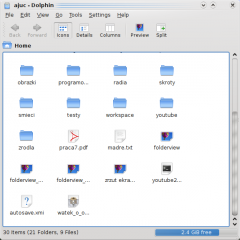
Wenn Sie Dolphin mithilfe des Kickoff Menüs starten, wird das Startverzeichnis angezeigt - standardmäßig ist das Ihr Home-Verzeichnis.
Eine Datei oder ein Verzeichnis öffnest du mit einem Einfachklick. (Dieses Verhalten kannst du auch in einen Doppelklick ändern, indem du die Systemeinstellungen öffnest und darin anwählst. Einige Distributionen haben bereits Doppelklick als Standard voreingestellt..) In KDE 4.5 wird diese Einstellungen unter in den Systemeinstellungen zu fnden sein.
Wenn du die Maus über ein Datei- oder Ordnersymbol bewegst, erscheint ein Plus- oder Minuszeichen. Wenn du auf das Pluszeichen klickst, wird die Datei der Auswahl hinzugefügt, wenn du auf das Minuszeichen klickst wird sie aus der Auswahl entfernt.
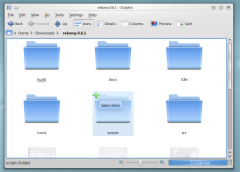
Wenn Sie auf das Plus-Zeichen klicken, wird die Datei bzw. der Ordner zu Ihrer Auswahl hinzugefügt. Sie können mehrere Elemente auf dieselbe Weise auswählen. Das Auswählen von Dateien und Ordnern kann auch durch das Ziehen eines Rechtecks mit der Maus (manchmal auch als „Gummiband“-Methode bezeichnet) geschehen. Das Auswählen und Abwählen ist auch mit Strg + Klick für einzelne Elemente und mit Umschalt + Klick für aneinandergereihte Elemente möglich.
Mehrere ausgewählte Elemente sehen wie folgt aus:

Einen neuen Ordner erstellen: Sie können einen neuen Ordner im aktuellen Verzeichnis mittels oder der Taste F10 erstellen.
Registerkarten: Dolphin unterstützt Registerkarten-Browsen. Eine neue Registerkarte kann über mit der Tastenkombination Strg + T oder wenn Sie mit der mittlere Maustaste auf ein Ordnersymbol oder Navigationsknöpfe klicken, geöffnet werden.
Dolphin öffnet standardmäßig, wenn Sie auf irgendeinen Ordner klicken. Das Programm kann auch vom Kickoff Menü gestartet werden.
Adressleiste
Dolohin beinhaltet ein neues Konzept, mit dem die Adressleiste schneller und präziser verwendet werden kann: die „Brotkrumen“-Adressleiste. Anstatt den kompletten Pfad darzustellen, werden nur die einzelnen Navigationspunkte, beginnend von einem Ihrer Orte, als Knopf dargestellt. Durch Klicken einer dieser Knöpfe gelangen Sie direkt zu besagtem Ordner. Auf diese Art können Sie einen übergeordneten Ordner von einem Unterordner aus rasch erreichen.
Zwischen den Knöpfen, die die Ordner widerspiegeln, befinden sich kleine Pfeile, die ebenfalls Knöpfe sind. Durch Klicken auf einen dieser Pfeile können Sie die Unterordner des jeweiligen Ordners sehen und somit schnell zu ihnen navigieren.
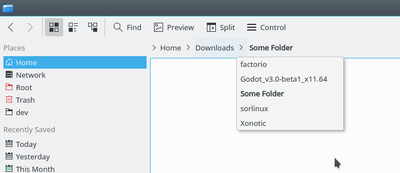
Es gibt ebenfalls eine klassische Adressleiste, die den kompletten Pfad anzeigt. Um dieser Ansicht zu verwenden, können Sie wählen oder die Tastenkombination Strg + L verwenden. Durch Klicken auf den freien Bereich neben der Adressleiste können Sie ebenfalls zur klassischen Ansicht wechseln. In der klassischen Ansicht ist ein Häkchen am Ende der Adressleiste sichtbar, welches wieder zur Brotkrumen-Ansicht wechselt. Natürlich können die zuvor genannten Methoden auch wieder verwendet werden, um zur vorigen Ansicht zurückzukehren.
Geteilte Ansicht
Dolphin bietet die Möglichkeit, die aktuelle Ansicht zuteilen, sodass zwei Ordner nebeneinander dargestellt werden, wie man es bereits vom Midnight Commander kennt. Dies ist eine sehr bequeme Möglichkeit, um Dateien von einem Ordner zum anderen zu verschieben oder zu kopieren.
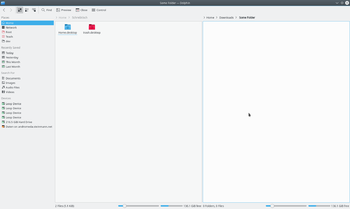
You can split the view by clicking on or, if you have enabled menu bar, (keyboard shortcut F3). To change back to only one folder view you can click again on or just press F3 again. The symbol will show you which view will be closed. Depending on the currently active view the minus sign will be shown in the left or right part of the symbol. The active view will be closed. This is important to know if you want to use the keyboard shortcut. There is also a button for splitting and closing the view situated in the toolbar. This button displays the minus symbol as well, so it is easy to know which view would be closed.
Selbstverständlich haben beide Seiten ihre eigene Adressleiste und beide Seiten können unterschiedliche Ansichtsmodi verwenden.
Ansichtsmodi
Dolphin unterstützt drei unterschiedliche Ansichtsmodi: „Symbole“, „Details“ und „Spalten“. Diese können über den Menüeintrag oder über die Tastenkürzel Strg + 1 (Symbole), Strg + 2 (Details) und Strg + 3 (Spalten) ausgewählt werden. Zudem gibt es einen Knopf für die einzelnen Ansichten in der Symbolleiste und das Kontextmenü des aktuellen Ordners beinhaltet ein Untermenü , mit dem die Ansicht gewechselt werden kann.
Symbole
Each file and each folder is represented by an icon in the view mode "Icons". Instead of displaying an icon a preview of the file can be shown. This behaviour can be turned on/off via the menu (if menu bar is enabled) or via the main toolbar button . There is a size limit for the file previews. This size limitation can be configured via option . There is also an option to use thumbnails embedded in files. In KDE 4.5 Previews are enabled (and maximum size defined) by . Starting from KDE 4.8, the aforementioned settings can be configured via .
Die Dateien und Ordner im aktuellen Verzeichnis sind standardmäßig alphabetisch sortiert. Die Art der Sortierung kann im Menü über gewählt werden. Die folgenden Sortierkriterien sind verfügbar:
- Dateiname
- Dateigröße
- Letzte Änderung
- Zugriffsrechte
- Eigentümer
- Gruppe
- Dateityp
Zudem kann die Sortierrichtung über umgekehrt werden.
Es gibt die Möglichkeit zusätzliche Informationen unterhalb des Symbols anzuzeigen. Diese können ein-/ausgeschaltet werden über . Im Prinzip können die selben Kriterien, die als Suchkriterium verfügbar sind, ausgewählt werden.
Für eine bessere Übersicht können Sie die Symbole gruppieren. Dies wird über aktiviert. Jetzt werden die Symbole mittels einer horizontalen Linie getrennt, welche den Name der Gruppe als Überschrift enthält. Die Gruppierung hängt von den ausgewählten Suchkriterien ab.
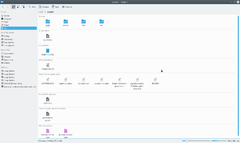
Details
In view mode "Details" additional information is displayed by default in contrast to view mode "Icons". All files are listed in a tabular. The context menu of the table header offers the possibility to add additional columns. The following columns are available:
- Dateigröße
- Änderungsdatum
- Zugriffsrechte
- Eigentümer
- Gruppe
- Dateityp
Die Spalte „Name“ wird immer angezeigt. Durch Klicken auf den Spaltenkopf wird die Ansicht nach dieser Spalte sortiert. Durch Klicken auf denselben Spaltenkopf wird die Sortierreihenfolge umgekehrt.
Since KDE 4.1 it is possible to display the folders as a tree. In this mode a plus sign is shown next to the folder. Plus sign has been replaced by > symbol in newer KDE versions. By clicking on this sign the folder is expanded and all containing sub folders and files are also shown in the table but they are attenuated. By clicking the sign, which displays a minus now (or an arrow pointing downwards in latest versions), again the expansion is closed again. Of course the tree structure can be used for as many folders as wished. In latest KDE releases, the tree view is enabled by default, but can be deactivated via with option .
Spalten
View mode "Columns" was inspired by the file manager Finder of Mac OS X. Entering a sub folder did not replace the current folder view but the content of the sub folder was listed in an additional column next to the column of the parent folder. This could be used for several hierarchies, so that you could navigate in an easy and fast way in the file system. Since KDE 4.8, view mode "Columns" has been dropped and will not be available in future Dolphin releases.
Setting defaults for all folders
Under (or under the menu item if you have enabled menu bar) you can set any of these attributes to be the default for all folder views.
Seitenleisten
Dolphin contains several panels, which can be activated via menu . Each panel can be placed in the left or right docking area. To move a panel you have to unlock panels (right clik on a panel and select ), click on the header and Drag&Drop the panel. The area where the panel will be placed on mouse released is highlighted. It is possible to stack panels on top of each other. In this case the panels are placed into tabs.
In the header of each panel there are two buttons. The button near to the caption undocks the panel. This makes the panel an independent window which "floats" above Dolphin. The window is still combined with Dolphin and cannot be displayed without Dolphin and cannot for example be minimized like normal windows. By clicking the button again the panel is docked again. The second button will close the panel.
Nicht-modale Dialogfenster
When Moving, Copying or Deleting files/directories the dialog disappears even when the operation has not yet completed. A progress bar then appears in the bottom right of the screen, this then disappears also, if you want see the progress you need to click a small (i) information icon in the system tray.

Orte
Dolphin contains a new kind of bookmarks Places. These are displayed in a panel which can be activated via (keyboard shortcut F9). The default Places are identical to the ones shown in the category Computer of the K-Menu Kickoff.
Durch Klicken einer dieser Orte wird er im aktuellen Fenster geöffnet. Das Kontextmenü bietet die Möglichkeit zum Bearbeiten und Entfernen derselben. Es ist zudem möglich, Einträge vorübergehend auszublenden.
Das Kontextmenü eines Ordners kann verwendet werden, um diesen Ordner zu den Orten hinzuzufügen. Daher gibt es einen Menüeintrag . Sie können einen Ordner auch auf die Seitenleiste ziehen, um ihn hinzuzufügen.
Die Orte-Seitenleiste beinhaltet auch Einträge von angeschlossenen Wechseldatenträgern, wie USB-Sticks oder CDs. Ein kleines Steckersymbol zeigt an, dass das Gerät eingehängt ist. Das Kontextmenü bietet die Möglichkeit das jeweilige Gerät auszuwerfen.
Die Orte werden als Grundlage für die Brotkrumen-Adressleiste verwendet. Jede Adresse wird in Relation zum nächsten Ordner angezeigt, der sich in den Orten befindet.
Informationen
The information panel can be activated via (keyboard shortcut F11). This panel displays a preview or an icon of the currently selected file/folder or of the file/folder below the mouse cursor. Some additional information like change date or size to the file/folder is displayed as well.
The information panel offers the possibility to rate files, add a comment or tag a file. This is one of the interfaces to the semantic Desktop Nepomuk which provides the advantages of the semantic web for the desktop. Starting from KDE 4.2 it is possible to search for the semantic links given by the tags.
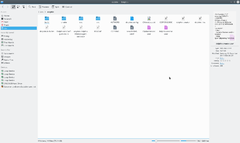

Ordner
A panel providing a tree structure for the file system can be displayed via (keyboard shortcut F7). The tree structure offers the possibility by clicking the > and ˇ signs to expand/collapse sub folders. By clicking on one of the folders the content will be displayed in the current view.
Konsole
The terminal emulator Konsole can be displayed directly in Dolphin via (keyboard shortcut F4). This makes it possible to use shell commands directly in Dolphin. The terminal is opened in the folder which is displayed in the current view. Shift + F4 opens Konsole in new window.
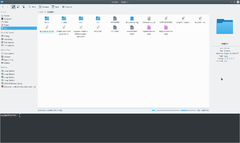
Externe Links
Road to KDE 4: Dolphin and Konqueror (englisch)
Ars Technica: A First Look at Dolphin
Youtube - KDE 4 rev 680445 - Dolphin
Introducing KDE 4 Blog - Dolphin
Lesezeichen und Orte
In KDE 3 konnte man Lesezeichen im Konqueroror erstellen, aber diese waren dann für keine andere Anwendung verfügbar. KDE SC 4 bietet hier weitreichende Flexibilität - aber leider bedeutet dies auch mehr Verwirrung. Tatsächlich gibt es in KDE SC 4 drei Arten von Lesezeichen, welche unterschieden werden müssen. Sie befinden sich in verschiedenen Dateien und haben verschiedene Aufgaben.
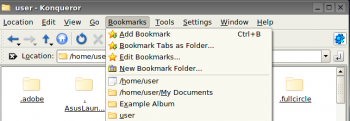
Drei Arten von Lesezeichen
First, there is the set of bookmarks available only to Konqueror - web bookmarks. These are stored in ~/.kde/share/apps/konqueror/bookmarks.xml. Then there is a set which Dolphin calls Places. This set is available to all applications as well as the Dolphin file manager. Every time you use you will see this set. The third set of bookmarks are Application Bookmarks. These share one file, regardless of the application that set them, and are available to all applications, unless you restrain them to a specific application. More of that later.
Lesezeichen aktivieren
In most distros Bookmarks are not enabled by default. In order to use bookmarks we first have to enable them. Open a in most KDE applications and you will see, at the right-hand edge of the icon panel, a spanner or wrench. From the drop-down list, choose .
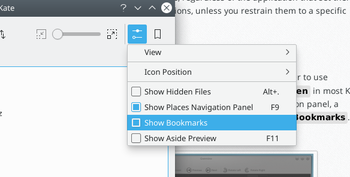
Es gibt ein paar standardmäßig eingerichtete Orte -
- Heimverzeichnis
- Netzwerk
- Wurzelverzeichnis
- Mülleimer
aber Sie können weitere hinzufügen. Klicken Sie dazu im Dolphin mit der rechten Maustaste auf einen einen Ordner und wählen Sie oder ziehen Sie einfach einen Ordner in die Orte hinein.
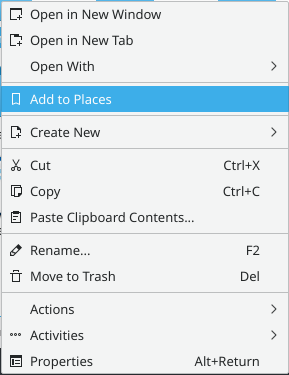
Standardmäßig wird jener Ort in allen Anwendungen zu sehen sein. Wenn Sie einen Ort nur im Dolphin angezeigt haben möchten, klicken Sie mit der rechten Maustaste in der Orte-Leiste auf den jeweiligen Ordner und wählen Sie den Eintrag, um ihn zu bearbeiten. In dem nun öffnenden Fenster gibt es ein Kontrollkästchen für .
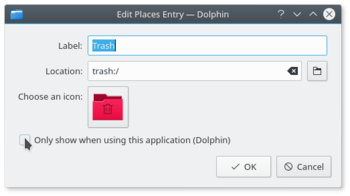
You can see the result of that command if you read ~/.kde4/share/apps/kfileplaces/bookmarks.xml.
In some applications too there is an option in the File menu to add a folder to Places. At this stage, however, applications vary in which features are available. The important thing to remember is that the default is for Places items to be available to all applications in the dialogue.
Lesezeichen in Anwendungen
This is the second class of bookmarks. Remember opening and using the spanner/wrench? Next to it is a yellow star. This is the bookmark management menu.
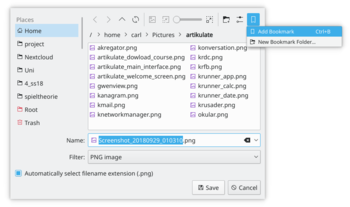
Here you can define bookmarks that will be visible in the same menu on any application. They are stored in one file, ~/.kde4/share/apps/kfile/bookmarks.xml, which is used by all applications having that menu.
Constraining to one application
Some applications allow you to edit items in the Places menu. For instance, if in Gwenview you right click on a folder in Places you can set an option to .
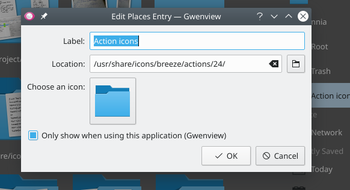
If you need to constrain to an application that does not yet allow you to do that, the only way left is to edit the file ~/.kde/share/apps/kfile/bookmarks.xml. Immediately before the </metadata> tag you will need to add the line
<OnlyInApp>appname</OnlyInApp>
Archiv-Verwaltung in Dolphin
Managing archives now becomes simple. In any directory in Dolphin, highlight the files that you want to compress, and right-click. Here, using the Compress option, you can elect to create a RAR archive, a Gzipped tar archive, or define another compression mode that you have already set up.
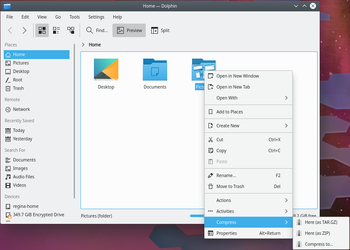
Similarly, if you right-click on an existing archived file you get a range of actions added to the right-click menu. You can extract the archive to the current folder, to an autodetected subfolder or to another place of your choosing.
Sollten Sie weitere Dateien zu einem bereits vorhandenen Archiv hinzufügen wollen, können Sie den Eintrag wählen.
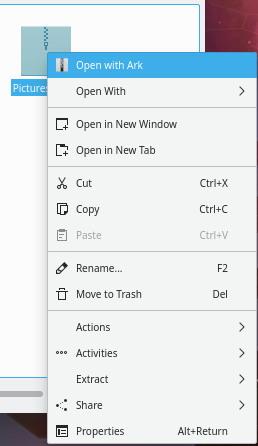
Weitere coole Dinge
Change a File Association on-the-fly
Have you ever wanted to open a file, only to find that it is associated with an application that is not of your choice? You can, of course, alter this in . But Dolphin and Konqueror offer you a quick and cool method for changing a single association.
Right-click on the file and select . The first line there is descriptive, something like:
Type: XML document
At the same level, on the right, there is a spanner (wrench). Click on that and you can add or change an association.
Similarly, by working on a folder, you can change the default file manager to/from Konqueror, if you choose, or add another image browser to the possible associations.
Das Untermenü „Aufgaben“
The sub-menu opens up a whole lot more cool things to do from Dolphin. Some possibilities only appear when applicable to the file you have selected. Some of the options are
- Convert an image file to a different format
- Preview the file
- Download a remote file with KGet
- Sign and/or encrypt the file, according to the encryption software installed
Audio-CD-Stücke kodieren und kopieren
- Legen Sie eine Audio-CD ein
- Navigieren Sie zu dieser CD im Dolphin: sie wird als „Laufwerk“ in Ihren Dolphin-„Orten“ auftauchen. Sie können Sie alternativ erreichen, indem Sie „audiocd:/“ in die Adressleiste eingeben.
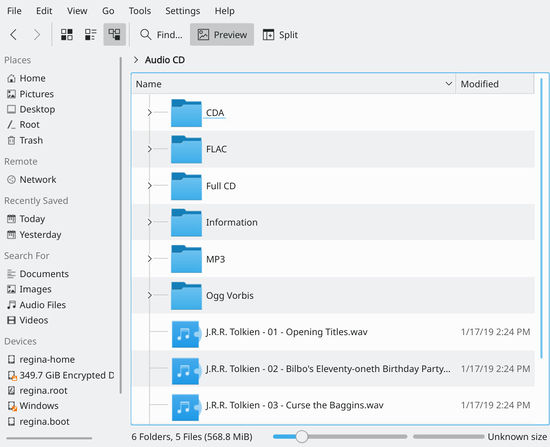
Man kann sehen, dass Dolphin für jedes Stück eine WAV-Datei bereithält sowie:
- einen CDA-Ordner, der die Index-Informationen im üblichen CDA-Format enthält,
- einen „Komplette CD“-Ordner, in dem eine Datei jeden Formates (.cda, .flac, .mp3, .ogg, .wav) ist, die alle Stücke beinhaltet,
- einen FLAC-Ordner, der alle Stücke im FLAC-Format beinhaltet (Verlustfreies Format),
- einen Informations-Ordner, der die CDDB-Informationen enthält,
- einen MP3-Ordner, in dem sich die Stücke im MP3-Format befinden,
- einen Ogg-Vorbis-Ordner, der die Stücke im OGG-Format enthält.
Sie müssen dann nur noch den Ordner Ihrer Wahl im bevorzugten Format irgendwohin kopieren, um die konvertierte Variante Ihrer CD zu erhalten!
Have your recent files as home
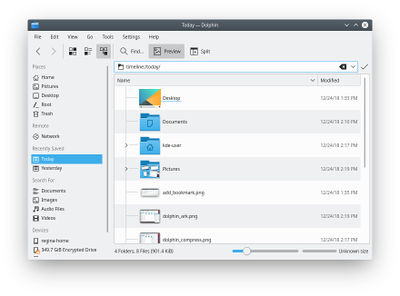
Dolphin has access to a large number of file transfer protocols (KIO Slaves). One of those is provided by the KDE semantic search system (Nepomuk). Nepomuk offers a transfer protocol named history. You can navigate to it by entering timeline:/ in the location bar.
One particularly neat thing there is the ability to have the Today folder from the timeline:/ protocol in the Places sidebar (you can just drag it there!). You can then change the name and icon (do a right click on the new Today entry and choose ).
It could be very useful to have this view of recently used files immediately when you start Dolphin. Unfortunately, as of Dolphin 2.1 (part of KDE SC 4.9) this is not possible without editing the Dolphin configuration file. See this blog for more details on that.
To edit the configuration file, first close all Dolphin windows. Dolphin will save its configuration upon closing, overwriting any changes you might make!
Then use KRunner (Alt + F2) to edit ~/.kde4/share/config/dolphinrc (or ~/.kde/share/config/dolphinrc, depending on your distribution) with KWrite as follows: kwrite ~/.kde4/share/config/dolphinrc. You can of course use any other editor as well, like Kate. In the configuration file, locate the [General] section to edit the HomeUrl into: HomeUrl=timeline:/today and save the file. You should now have the today view as default and have the files you're most often looking for at your fingertips!
